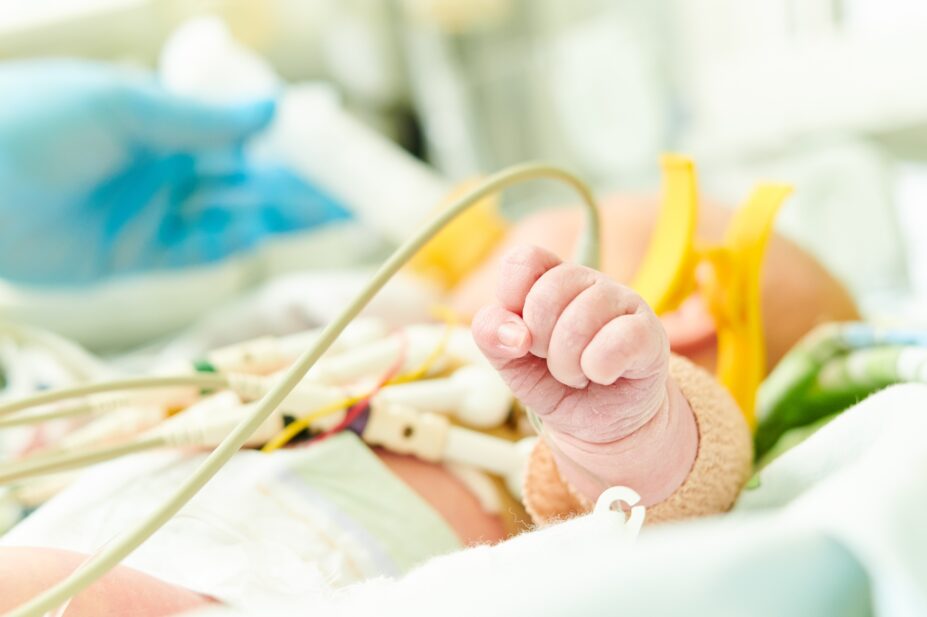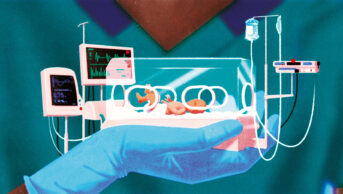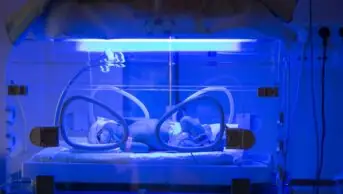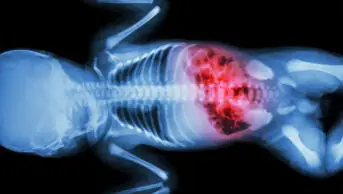
Shutterstock.com
After reading this article, you should be able to:
- Understand the physiological differences between neonates and older children/adults;
- Appreciate the pharmacokinetic and pharmacodynamic differences between neonates and children/adults and be able to apply this knowledge to medicines use;
- Recognise the potential risks associated with medicines used in neonates and find solutions to reduce these risks.
The World Health Organization defines a neonate as a child up to 28 days in age[1]. Babies born after 37 weeks gestation are classified as ‘term’. Nearly 58,000 babies are born prematurely in the UK each year, meaning that 1 in every 13 babies is born prematurely[2]. There are approximately 200 neonatal units throughout the UK, providing specialist care for this patient population[3].
There are three different types of neonatal unit:
- Level 1: special care baby unit for babies requiring initial and short-term care;
- Level 2: local neonatal units for babies requiring high dependency care;
- Level 3: neonatal intensive care units for babies with complex care needs[3].
Pharmacy staff may be involved in the care of patients in any of the above settings. They may also be involved in caring for babies in transitional care units on maternity wards, where babies who require extra care and monitoring can be looked after without needing to be admitted to a special care baby unit[4].
In 2019, NHS England published a report titled ‘Implementation of recommendations of the neonatal critical care transformation review’, which recognised that pharmacists (and other allied healthcare professionals) are an essential component of the neonatal multidisciplinary team[5]. Pharmacists possess in-depth knowledge about safe and effective medicines use, which enables them to optimise medication regimes and make appropriate monitoring recommendations[6].
In recognition of the important role of pharmacists in the neonatal care setting, the Chief Paediatric Pharmacists Group (CPPG) Neonatal and Paediatric Pharmacy Group (NPPG) published neonatal staffing recommendations in 2022[7]. These recommendations take into consideration the number of cots and the type of care being offered (level 1, 2 or 3). They recommend the level of funding (e.g. Agenda for Change band 7 or band 8a equivalent) each unit should provide in terms of pharmacy support. Attendance at daily ward rounds and becoming an independent prescriber are strongly encouraged[7].
Neonates pose a unique challenge when it comes to medicines administration owing to their physiology. This article will discuss the important pharmacokinetic and pharmacodynamic differences between neonates and older children, and their effects on drug absorption, metabolism and elimination.
Pharmacokinetics and pharmacodynamics in neonates
One of the main differences between neonates and older children/adults is the distribution of water and fat in their bodies. The changes that occur during development are illustrated in the figure below[8]:
These differences have a big impact on the distribution of water-soluble and fat-soluble drugs.
With highly water-soluble drugs, such as aminoglycosides, there is a larger volume of distribution in neonates, meaning that plasma concentrations may appear lower than expected. A lower volume of distribution may be seen with fat-soluble drugs, such as diazepam[9,10].
The main protein involved with drug binding in plasma is albumin. The quantity of albumin is reduced in neonates and its composition differs. Foetal albumin is present in higher quantities in neonates and this has a reduced binding affinity compared with normal human albumin. This leads to higher amounts of free drug present in neonates’ plasma, leading to increased risks of toxicity[10]. For highly protein-bound drugs (e.g. phenobarbital and furosemide) lower doses may be recommended to achieve the same therapeutic effect. Phenytoin (a highly protein-bound drug) has a lower therapeutic target range in neonates compared with older children (6–15mg/L in neonates vs 10–20mg/L in children/adults) to account for this difference in protein-binding capacity[11].
Drug absorption
Drug absorption in neonates differs in many ways, including via oral, intramuscular, rectal and percutaneous routes[10].
In term infants, gastric pH values are around 6–8 at birth, they fall to 2–3 within the first few hours of life, they rise to 6–8 again within 24 hours, and then gradually fall to ‘adult’ values within 20–30 months[9]. In preterm infants, the initial high gastric pH period is prolonged. This can lead to an increased absorption of basic drugs (e.g. ketoconazole) and a reduced absorption of acidic drugs (e.g. phenytoin)[10].
Gastric emptying is slower in neonates and young children (i.e. those aged under five years), compared with older children. It might be expected that drugs have an improved absorption rate in neonates, owing to prolonged contact with the gastrointestinal mucosa, secondary to slow gastric emptying. However, the time it takes to reach maximum plasma levels for orally administered drugs, such as digoxin, appears to be increased[12]. Gastro-oesophageal reflux disease is fairly common in neonates and this can affect the oral absorption of medications, owing to frequent vomiting and regurgitation of feeds.
The intramuscular route is generally avoided in neonates because neonates have a reduced muscle mass and reduced muscle blood flow leading to slower and unpredictable drug absorption[13]. There is also a risk of muscle damage if too great a volume is injected. However, intramuscular injections are the preferred route in some circumstances; for example, vitamin K injections given at birth to prevent haemorrhagic disease of the newborn[14]. Vitamin K can be administered orally at birth, but requires repeated administrations at age 1 week and at 4–6 weeks[15].
The rectal route is sometimes used in neonates, but absorption can be unpredictable owing to the frequency of rectal contractions[16]. This leads to faster rates of expulsion of drugs such as paracetamol. Another issue is the lack of suitable rectal preparations for premature neonates and inaccuracies in dosing[16]. A ‘chip’ of a glycerol suppository may be prescribed to help relieve constipation, or ‘a fraction’ of a choral hydrate suppository may be prescribed for sedation. It is very difficult to deliver an accurate dose when nursing staff attempt to cut suppositories, as the formulations available are designed to deliver bigger doses (to adults). There may also be difficulties in how these instructions are being interpreted — a ‘chip’ may mean difference sizes to different people.
Drug metabolism and elimination
Major changes in liver and kidney function occur during the neonatal period[17,18]. The amount and activity of enzymes vary with age, maturation, gender and genetic constitution.
Drug metabolism usually involves two stages — phase I and phase II. In phase I, functional polar groups on a drug molecule undergo oxidation, reduction or hydrolysis, via the action of cytochrome p450 enzymes. In phase II, drug metabolites/parental compounds undergo glucuronidation, sulfonation, methylation, acetylation, glutathione or amino acid conjugation to create inactive excretion products that can be eliminated via urine or bile[9,10].
In neonates, developmental variations are apparent for many phase I and phase II enzymes. Appearance, activity and expression of phase I enzymes changes markedly throughout development. Changes in expression of cytochrome p450 enzymes occur during foetal development and in the first few hours, weeks and months after birth[9]. The elimination half-life of phenytoin in preterm infants is 75 hours at birth, this decreases to 24–48 hours in term infants and further decreases to 8 hours by 14 days postnatal age[10]. The elimination half-life of theophylline is 8–18 hours in term infants but decreases to 3–4 hours by 48 weeks of life, owing to the maturation of liver enzymes[19]. Sulfation is the major metabolic pathway for paracetamol during the neonatal period, changing to glucuronidation over several months[9].
Developmental changes in renal function (particularly glomerular filtration and active tubular secretion) affect the renal excretion of many drugs[20]. In a preterm neonate, the kidneys are still undergoing development. Renal function at birth and how it develops after birth are related to maturity of developing nephrons. The glomerular filtration rate increases rapidly in first two weeks of life following birth owing to adaptive changes in renal blood flow and recruitment of mature, functioning nephrons[21]. This impacts on renally cleared drugs, such as benzylpenicillin and vancomycin[21].
The BNF for Children recommends administering benzylpenicillin every 12 hours in babies under 7 days postnatal age. The recommended dose frequency changes to every 8 hours in babies aged 7 to 21 days and to every 6 hours in babies over 21 days[22]. With vancomycin, the dose interval is dependent on gestational age: for neonates under 29 weeks, the recommended interval is every 24 hours; from 29–35 weeks, the interval is every 12 hours; and for babies over 35 weeks corrected gestational age, the recommended dose interval is every 8 hours[23]. For aminoglycosides, the dosing interval in preterm babies may need to be extended to 36- or 48-hourly[24,25].
The Cockcroft and Gault equation is a poor predictor of renal function in neonates because neonates have such a low muscle mass[26]. Urine output is usually considered a more reliable indicator of renal function, with values <1mL/kg/hour indicating that an acute kidney injury may be present[27].
When considering the differences in drug metabolism and elimination in neonates, refer to published literature (e.g. BNF for Children) to assess how the dose/frequency of a medication should be altered — individual neonatal units may also have local guidance, which take these considerations into account.
Calculations
Prescribing medicines to neonates involves several complex dosage calculations[28]. Doses are often calculated individually, based on parameters such as weight or body surface area. The publication of the BNF for Children in 2005 was a tremendous step forwards in terms of having a national resource where neonatal and paediatric dosing information was readily accessible[29].
Many hospitals develop their own in-house neonatal formularies. Each formulary will have its own workflow, monograph template and update routine. There is a risk that clinicians may misunderstand or misinterpret the content of a formulary monograph, if they are less familiar with its content and style[30].
Medication errors in neonates frequently involve prescriptions where decimal points are present — doses should be rounded to a practical volume to be administered wherever possible[28]. Another frequent problem may be a misunderstanding or misinterpretation of dose units — these should be written up in full to minimise risk (e.g. micrograms NOT mcg). A licensed drug formulation may be commercially available labelled in milligrams, but the dose may be prescribed in micrograms or nanograms (e.g. dinoprostone, alfacalcidol). Electronic prescribing systems can be introduced to assist with these issues but cannot eliminate the problem entirely.
Dosage forms and concentrations
One of the major issues facing healthcare professionals looking after neonates is a lack of suitable dosage forms and concentrations[31]. One study showed that in 31% of neonatal prescriptions, a dose could be administered with less than one tenth of the contents of a vial. In 5% of cases, a neonatal dose could be administered using less than one hundredth of the contents[32].
The NPPG and Royal College of Paediatrics and Child Health (RCPCH) are lobbying pharmaceutical manufacturers to produce drugs in concentrations that are more suitable for administration in the neonatal population, and standardising concentrations nationally is seen as an important step in making these ambitions a reality. In February 2023, the RCPCH published recommendations for standard concentration infusions for the five most commonly used continuous drug infusions in neonatal units (adrenaline, dinoprostone, dopamine, dobutamine and morphine) for patients weighing under 2kg and there are more recommendations in development. A standard weight-based approach to standard concentrations is proven to be safer and more efficient for patient care. The proposed framework is not complete but offers the first list of published standard IV infusion concentrations in the UK. It will support strategic efficiencies, the development of “smart pump” drug libraries, the uptake and implementation of electronic prescribing and the future development of licensed formulations[33].
Excipients
Medicines often contain excipients that are unsuitable for neonates and are potentially harmful[34]. A well-known example is the licensed formulation of phenobarbital elixir, which contains 38% alcohol. Other examples include amiodarone injection and lorazepam injection, both contain benzyl alcohol as a preservative, which can cause gasping syndrome in neonates[35]. Phenobarbital injection contains 90% propylene glycol, which can lead to hyperosmolality, lactic acidosis, seizures and cardiac arrhythmias[35]. Chloramphenicol injection is contraindicated in neonates owing to the risks of grey baby syndrome, a life-threatening complication that can cause abdominal distension, haemodynamic collapse and an ashen-grey skin discolouration[36].
Exposure to these excipients should be minimised as much as possible, but a medicine containing a problem excipient may be indicated after a careful risk assessment. Ordering medications from the same supplier should minimise variations in products and decrease the risk of harm — if a medication is not available and an alternative is sought, always check the list of ingredients and the amount of excipients the product contains[37].
If an IV medicine is supplied as a dry powder, one major consideration when giving part-vial doses to neonates is the displacement value of the powder. If the displacement value is not considered, it can affect the amount of drug administered to a neonate. The easiest way to address the issue is to subtract the displacement value from the total amount of fluid that would be used to reconstitute the vial[28]. Medusa is the UK’s national injectable medicines guide and contains useful recommendations about when and how to manage displacement values for different IV preparations[38].
Infusion rates
Another important consideration is the rate of a drug infusion. If a drug is given too rapidly, there is potential for harm. The administration time of ceftriaxone infusion in neonates is over 60 minutes, to reduce the displacement of bilirubin from albumin, thus reducing the risk of bilirubin encephalopathy[39]. IV drug compatibility is a major consideration — ceftriaxone is contraindicated in neonates if they require (or are expected to require) calcium-containing infusions (e.g. parenteral nutrition) because of the risk of precipitation of ceftriaxone-calcium in the neonatal vasculature[39].
Communicating with families
Having a child in the neonatal unit can be a very stressful time for parents and they may have a number of questions for the pharmacy team about their baby’s medicines. It is important that the pharmacist listens and responds to the questions being asked, which may vary over time as the child’s condition changes and develops, and delivers any information requested in a clear and empathetic way.
Family-integrated care promotes a culture of partnership between families and neonatal staff, which enables parents to become more confident, knowledgeable and independent[40]. Parents may be asked to be involved with administering medicines to their babies whilst they are on the unit, to prepare them for discharge home. It is particularly important that families/caregivers know how to administer medications correctly to their child, and that they are supplied with the correct devices; for example, an appropriate-size enteral syringe to deliver a liquid medication.
The charity Bliss, for babies born premature or unwell, has an excellent website to help parents understand how neonatal units function, and the role of each member of staff, including pharmacists[41]. Parents can also be directed to useful resources on the ‘Medicines for Children’ website, such as ‘How to give medicines via a nasogastric tube’[42].
A collaborative study — ‘PADDINGToN’ (Parent co-Designed Drug Information for Parents and Guardians Taking Neonates Home) — concluded in 2022[43], which led to the creation of useful guides for parents of neonates requiring medicines when they leave hospital. The guides can be downloaded from the Medicines for Children website and shared with families[44]. Tools include a medicines information booklet, and a medicines administration record, so parents can record medicines they are giving at home.
Best practice
Practical points and important messages
- Familiarise yourself with national and local neonatal formularies/guidelines, to ensure you know how to apply them in neonatal patients, at different stages of organ development;
- Be aware of potential harmful excipients and liaise with your procurement team to ensure that the medications you supply can be safely administered to neonates;
- Speak to medical and nursing colleagues about the challenges they face when prescribing/ administering medications to neonates and agree on ways to minimise risk (e.g. avoiding decimal points, sensible rounding of doses);
- Take a look at useful resources, such as the PADDINGToN medicines information booklet on the Medicines for Children website and identify families who would benefit from receiving a copy on discharge from hospital.
- 1Newborn health in the Western Pacific. World Health Organisation. https://www.who.int/westernpacific/health-topics/newborn-health#:~:text=A%20newborn%20infant%2C%20or%20neonate,at%20highest%20risk%20of%20dying (accessed April 2024)
- 2Perinatal Mortality Surveillance Report. UK Perinatal Deaths for Births from January to December 2019. MBRRACE-UK. 2021. https://www.npeu.ox.ac.uk/assets/downloads/mbrrace-uk/reports/perinatal-surveillance-report-2019/MBRRACE-UK_Perinatal_Surveillance_Report_2019_-_Tables_and_Figures_V1.pdf (accessed April 2024)
- 3Neonatal unit guide. Infant Journal. https://www.infantjournal.co.uk/nicu_list.html (accessed April 2024)
- 4McKeon-Carter R. Neonatal transitional care-a concept not a place. Infant. 2018;14.
- 5Implementing the Recommendations of the Neonatal Critical Care Transformation Review. NHS England. 2020. https://www.england.nhs.uk/publication/implementing-the-recommendations-of-the-neonatal-critical-care-transformation-review/#:~:text=Implementing%20the%20Recommendations%20of%20the%20Neonatal%20Critical%20Care%20Transformation%20Review,-Document%20first%20published&text=This%20action%20plan%20to%20implement,the%20NHS%20Long%20Term%20Plan (accessed April 2024)
- 6Pharmacists. British Association of Perinatal Medicine. https://www.bapm.org/pages/203-pharmacists (accessed April 2024)
- 7Pharmacy Staffing Standards for Neonatal Services . Neonatal and Paediatric Pharmacy Group. 2022. https://nppg.org.uk/wp-content/uploads/2022/10/NPPG-Neonatal-Staffing-Standards-V2.pdf (accessed April 2024)
- 8Murphy J. Clinical Pharmacokinetics pocket reference. Bethesda, Maryland: American Society of Health-System Pharmacists 2012.
- 9Lu H, Rosenbaum S. Developmental Pharmacokinetics in Pediatric Populations. The Journal of Pediatric Pharmacology and Therapeutics. 2014;19:262–76. https://doi.org/10.5863/1551-6776-19.4.262
- 10Fernandez E, Perez R, Hernandez A, et al. Factors and Mechanisms for Pharmacokinetic Differences between Pediatric Population and Adults. Pharmaceutics. 2011;3:53–72. https://doi.org/10.3390/pharmaceutics3010053
- 11Phenytoin: Monitoring requirements in children. BNF for Children. https://bnf.nice.org.uk/drugs/phenytoin/#:~:text=In%20children,-Therapeutic%20plasma%2Dphenytoin&text=Trough%20plasma%20concentration%20for%20optimum,%E2%80%9380%20micromol%2Flitre (accessed April 2024)
- 12Heimann G. Enteral absorption and bioavailability in children in relation to age. Eur J Clin Pharmacol. 1980;18:43–50. https://doi.org/10.1007/bf00561477
- 13Tayman C, Rayyan M, Allegaert K. Neonatal Pharmacology: Extensive Interindividual Variability Despite Limited Size. The Journal of Pediatric Pharmacology and Therapeutics. 2011;16:170–84. https://doi.org/10.5863/1551-6776-16.3.170
- 14Ng E, Loewy AD. Guidelines for vitamin K prophylaxis in newborns. Paediatrics & Child Health. 2018;23:394–7. https://doi.org/10.1093/pch/pxy082
- 15Phytomenadione. BNF for Children. https://bnfc.nice.org.uk/drugs/phytomenadione/#indications-and-doseICE (accessed April 2024)
- 16Jannin V, Lemagnen G, Gueroult P, et al. Rectal route in the 21st Century to treat children. Advanced Drug Delivery Reviews. 2014;73:34–49. https://doi.org/10.1016/j.addr.2014.05.012
- 17Grijalva J, Vakili K. Neonatal liver physiology. Seminars in Pediatric Surgery. 2013;22:185–9. https://doi.org/10.1053/j.sempedsurg.2013.10.006
- 18Doherty T, Hu A, Salik I. Physiology, Neonatal. Statpearls. 2024. https://www.ncbi.nlm.nih.gov/books/NBK539840/ (accessed April 2024)
- 19Wong I, Tuleu C, Costello I, et al. Paediatric Drug Handling . London: Pharmaceutical Press 2007.
- 20Ligi I, Boubred F, Grandvuillemin I, et al. The neonatal kidney: implications for drug metabolism and elimination. Curr Drug Metab. 2013;14:174–7.
- 21Stritzke A, Thomas S, Amin H, et al. Renal consequences of preterm birth. Mol Cell Pediatr. 2017;4. https://doi.org/10.1186/s40348-016-0068-0
- 22Benzylpenicillin sodium. BNF for Children. https://bnfc.nice.org.uk/drugs/benzylpenicillin-sodium/ (accessed April 2024)
- 23Vancomycin indications and dose. BNF for Children. https://bnfc.nice.org.uk/drugs/vancomycin/#indications-and-dose (accessed April 2024)
- 24Nestaas E. Aminoglycoside extended interval dosing in neonates is safe and effective: a meta-analysis. Archives of Disease in Childhood – Fetal and Neonatal Edition. 2005;90:F294-f300. https://doi.org/10.1136/adc.2004.056317
- 25Stickland MD. An extended interval dosing method for gentamicin in neonates. Journal of Antimicrobial Chemotherapy. 2001;48:887–93. https://doi.org/10.1093/jac/48.6.887
- 26Pierrat A, Gravier E, Saunders C, et al. Predicting GFR in children and adults: A comparison of the Cockcroft-Gault, Schwartz, and Modification of Diet in Renal Disease formulas. Kidney International. 2003;64:1425–36. https://doi.org/10.1046/j.1523-1755.2003.00208.x
- 27Branagan A, Costigan CS, Stack M, et al. Management of Acute Kidney Injury in Extremely Low Birth Weight Infants. Front. Pediatr. 2022;10. https://doi.org/10.3389/fped.2022.867715
- 28Dixon A, Evans C. Intravenous therapy: Drug calculations and medication issues. Infant. 2006;2:110–4.
- 29BNF for Children. BNF for Children. https://bnfc.nice.org.uk/ (accessed April 2024)
- 30Shaniv D, Bolisetty S, Young TE, et al. Neonatal Drug Formularies—A Global Scope. Children. 2023;10:848. https://doi.org/10.3390/children10050848
- 31O’Brien F, Clapham D, Krysiak K, et al. Making Medicines Baby Size: The Challenges in Bridging the Formulation Gap in Neonatal Medicine. IJMS. 2019;20:2688. https://doi.org/10.3390/ijms20112688
- 32Chappell K. Potential tenfold drug overdoses on a neonatal unit. Archives of Disease in Childhood – Fetal and Neonatal Edition. 2004;89:F483–4. https://doi.org/10.1136/adc.2003.041608
- 33Neonatal and Paediatric Pharmacists Group. Standardising intravenous infusion concentrations for neonates and children in the UK. Royal College of Paediatrics and Child Health. 2023. https://www.rcpch.ac.uk/sites/default/files/2023-12/standard_infusions_feb_2023.pdf (accessed April 2024)
- 34Valeur KS, Holst H, Allegaert K. Excipients in Neonatal Medicinal Products: Never Prescribed, Commonly Administered. Pharm Med. 2018;32:251–8. https://doi.org/10.1007/s40290-018-0243-9
- 35Clouser A, Diseroad E. Harmful excipients for pediatric patients. Contemporary Pediatrics. 2022;39.
- 36Cummings E, Kong E, Edens M. Gray baby syndrome. Statpearls. Published Online First: 28 August 2023.
- 37How to identify and manage ‘problem’ excipients in medicines for children. Pharmaceutical Journal. 2017. https://doi.org/10.1211/pj.2017.20203121
- 38NHS Injectable Medicines Guide. Medusa. https://www.medusaimg.nhs.uk/ (accessed April 2024)
- 39Ceftriaxone 1g Powder for Solution for Injection or Infusion. Electronic Medicines Compendium. 2023. https://www.medicines.org.uk/emc/product/1361/smpc#gref (accessed April 2024)
- 40Family Integrated Care. British Association of Perinatal Medicine. 2021. https://www.bapm.org/resources/ficare-framework-for-practice (accessed April 2024)
- 41Resources for parents. Bliss. https://www.bliss.org.uk/health-professionals/information-and-resources/resources-for-parents (accessed April 2024)
- 42How to give different types of medicines. Medicines for Children. https://www.medicinesforchildren.org.uk/advice-guides/giving-medicines/ (accessed April 2024)
- 43Gill A, Bracken L, Barker C, et al. Parent co-Designed Drug Information for parents and Guardians Taking Neonates home (PADDINGToN) a mixed method approach to defining and evaluating information resources. 2022. https://doi.org/10.1101/2022.07.10.22277472
- 44Medicines information for parents and carers taking babies home with medicines. Medicines for Children. https://www.medicinesforchildren.org.uk/news/medicines-information-for-parents-and-carers-taking-babies-home-with-medicines/#:~:text=Giving%20medicines%20to%20babies&text=The%20%27PADDINGToN%20Study%27%20(Parent,College%20of%20Surgeons%20in%20Ireland (accessed April 2024)


